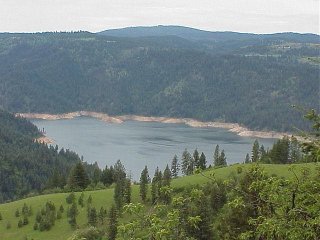forum
library
tutorial
contact

New Fight Over Dworshak Reservoir Water
by Bill RudolphNW Fishletter, May 11, 2004
|
the film forum library tutorial contact |

|
New Fight Over Dworshak Reservoir Waterby Bill RudolphNW Fishletter, May 11, 2004 |
A new water squabble took shape last week, as federal agencies in the Columbia Basin took a closer look at draining more water from an Idaho reservoir to offset fish losses for a proposed reduction in summer spill at mainstem dams. The agencies had expected to announce a final "amended" proposal by April 21, but after fielding more comments from state agencies and tribes, the process to refine offsets for both ESA listed and non-listed fish stocks has dragged on.
It may take another week or two before it's ready, said BPA spokesman Mike Hansen. The main elements of the proposed offsets, increasing the pikeminnow bounty program, and reducing fluctuations in the Hanford Reach, are still not completed, and a deal to reduce harvest in the lower river hasn't been worked out. Washington has also asked BPA to pay millions for hatchery improvements as part of the three-year spill evaluation that BPA hopes could save about $45 million a year.
 A new analysis by NOAA Fisheries trotted out at last week's IT [Implementation Team] meeting in Portland suggests that adverse impacts to fall chinook could be greater than earlier estimates--especially in a low flow year--and by drafting another 20 feet out of Dworshak Reservoir juvenile fish survival could be boosted in early September by adding cool water from the Clearwater to the lower Snake.
A new analysis by NOAA Fisheries trotted out at last week's IT [Implementation Team] meeting in Portland suggests that adverse impacts to fall chinook could be greater than earlier estimates--especially in a low flow year--and by drafting another 20 feet out of Dworshak Reservoir juvenile fish survival could be boosted in early September by adding cool water from the Clearwater to the lower Snake.
As usual, Dworshak reservoir water was used last year to augment flows and reduce temperatures for ESA fish in the Snake, which meant the reservoir level declined by about 85 feet between July and September, a strategy that has had local residents furious for years. It's one of the salmon recovery strategies cemented into the hydro BiOp.
The latest salmon math from NOAA Fisheries is still in what critics call the "decimal dust," or margins of error bounds, but it suggests that if the reduced spill proposal had been in place when the 2002 returning adults (2,116 wild falls) migrated "typically" to sea, 18 to 40 less adults would have returned. If the juvenile migration had been late, 21 to 45 less fall chinook would have returned. Adverse effects on hatchery fish from Lyons Ferry were estimated at about twice the rate of wild fish. But with thousands more of them returning (7,831 fish in 2002) than from the wild component, NOAA estimated a 100-fish to 270-fish loss, depending on whether the juvenile run migrated early or late.
The NOAA Fisheries draft analysis of the extra Dworshak draft estimates the number of Snake River fall chinook saved by the 20-foot release "would likely offset the adverse effect of the reduced spill operation." But the analysis estimates that during a typical juvenile migration only 1 percent of the fall run is passing through during the first two weeks in September.
The analysis said the draft would provide more benefits in years when the migration is late, when up to 4 percent of the run passes during that two-week time frame. However, In the past nine years, the migration has appeared late only once.
In years when the migration is early, which occurs about one-third of the time, the analysis said there would be no survival benefit at all.
A Corps of Engineers' analysis distributed at the same time, said the cool water from Dworshak takes about two weeks to get to Lower Granite to do much good, when it can reduce water temperatures by about 3.4 degrees F.
"If the goal is to avoid exceedences of the 68 degree standard, this can be done without the increased draft of the Dworshak reservoir," says the Corps' analysis, by releasing water more evenly from the reservoir in July and August.
The Dworshak draft has turned quickly into a political football, with Orofino, Idaho, the center of the region's recreational activities, the focal point for complaints about losing another 20 feet of the reservoir's elevation. "It makes it even tougher to re-fill," said Sandy Medley, executive director of the Orofino Chamber of Commerce. Though BPA has offered to spend $1.5 million to fund a core project that would pay for extending boat ramps, including $425,000 for a Nez Perce project to survey cultural resources, Medley said Orofino residents would rather have the water.
"We'll be meeting with Bob Lohn (NOAA fisheries), the Corps and BPA to see where we stand," said Medley.
Idaho's attorney general Michael Bogert, in an April 7 letter to BPA, said the state has "serious reservations" about the strategy. He said that not only would increased draft of the reservoir make it more difficult to fill up again in the spring, a 2000 study by Idaho's own Department of Water Resources found that increased flows from Dworshak had "a negligible impact on anadromous fish."
Judi Danielson, chair of the Northwest Power and Conservation Council, said she and fellow Idaho representative Jim Kempton supported the local folks and were backed up by Idaho's congressional delegation.
The NOAA analysis also looked at a proposal by Oregon and Washington fish managers to augment July flows in the lower Snake by adding another 100,000 acre-feet from Brownlee Reservoir. It estimated the survival benefit to juvenile salmon on the order of 1.5 percent.
learn more on topics covered in the film
see the video
read the script
learn the songs
discussion forum
